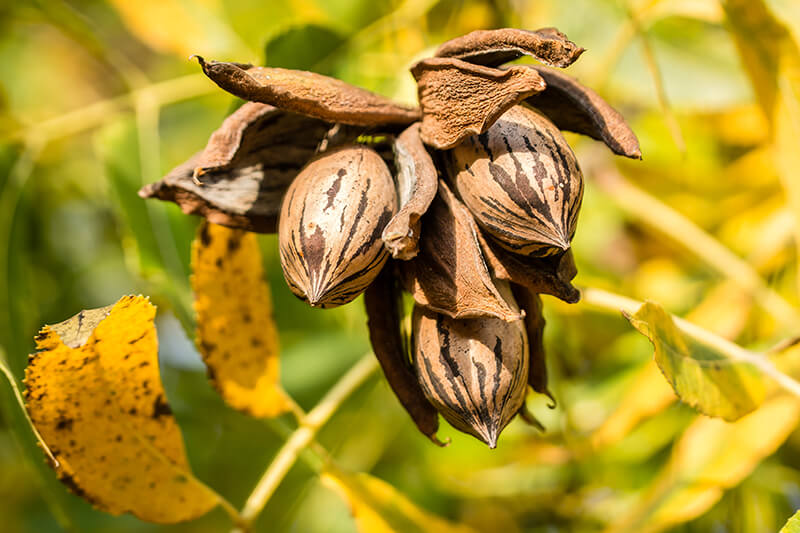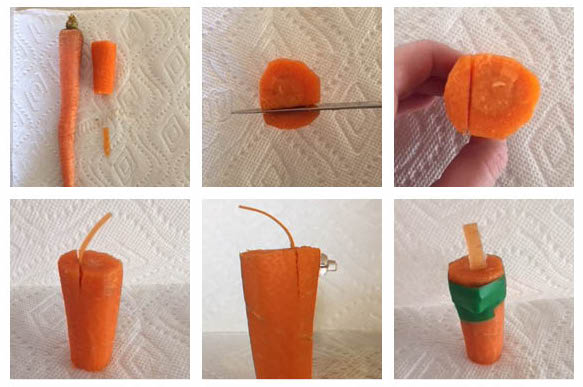Pecan trees are native to North America, and their history can be traced back to the 16th century. These native trees were wild trees that grew along rivers, lakes, or any large source of water. Pecan is a Native American word from the Algonquin tribe meaning "nut requiring a stone to crack." Because pecans were close at hand, many tribes used wild pecans as a major food source. It is believed that the Native Americans were the first to cultivate pecan trees. Not only did the Native American tribes eat the pecans, they also used the wood to make bows and made oil by boiling pecan pieces in water and straining the mixture.
Through trade, pecans became very popular in the US and throughout the world. In the 1770s, pecans even made their way to George Washington and Thomas Jefferson, who both planted pecan tress on their plantations. The trees are still standing today! It wasn't until the late 1800s that farmers began cultivating pecans in orchards.
Today, pecans are grown in 15 states in the southern United States including Alabama, Arkansas, Arizona, California, Florida, Georgia, Kansas, Louisiana, Missouri, Mississippi, North Carolina, New Mexico, Oklahoma, South Carolina, and Texas. Georgia, New Mexico, and Texas are the top pecan-producing states. The U.S. is the world's leading producer of pecans, producing about 80% of the world's pecan supply.1
The pecan varieties with high-quality nuts often come from trees with weak roots. Varieties with strong roots have poor-quality nuts. To get high-quality nuts on strong roots, pecan farmers insert a scion from a high-quality nut variety into a strong rootstock variety. This procedure is called grafting. Once the graft heals, the grafted seedlings will be planted in an orchard.
It takes 7 years for the pecan trees to grow and start producing nuts. During those 7 years, farmers must continually water and take care of the trees. Pecan farmers must invest a lot of money before any money comes back to their farm. Once an orchard is established, farmers must keep them in good condition. Just like humans need nutrients and minerals to live, so do pecan trees. Farmers spray the trees to keep away bugs and disease. If the trees are lacking in any nutrients, farmers will spray those nutrients onto the leaves so the tree can absorb them at once.
Pecan trees require 4-5 acre-feet of water per year. An acre-foot of water is enough water to cover an acre of land (43,560 square feet or about the size of a football field) 1 foot (30.48 centimeters) deep. Farmers will put a couple of inches (about 5 centimeters) of water per acre each time they water. To get enough water to the trees, some farmers release water form ditches to flood the pecan orchards. This practice is called flood irrigation.
Pecan trees are wind-pollinated. Though they can self-pollinate (they have both male and female flowers on the same tree), pecan trees produce more nuts when they are cross-pollinated (having multiple trees close enough to pollinate each other). Pecan trees begin to pollinate in May and the nuts grow for 90 days.
There are two different methods used by farmers when harvesting pecans. Some farmers wait until the temperature drops below 32°F (0°C) to begin the harvest. The freeze opens the husks surrounding the pecan. Harvest usually begins in October or November and can last through January. Other farmers will start their harvest earlier, before all of the husks are open. This allows them to sell their pecans early and get a high price for the first harvest. They will then harvest a second time once all of the pecan husks are open. There are positives and negatives to both practices. Farmers that wait until all of the husks are open save on the cost of harvesting twice, but they get a lower price for their pecans. Farmers that begin harvesting early lose money by harvesting twice, but they get a higher price for their first harvest.
To harvest, farmers first use a mechanical tree shaker to shake the pecans out of the trees. They then use a pecan sweeper to sweep the pecans, leaves, and sticks into a windrow, a long line of material heaped into a row. Once the windrow is complete, a pecan harvester picks up the pecans while spitting out the leaves and sticks. The collected pecans are sent to a facility where they are cleaned, shelled, and packaged ready for you to eat!
Pecans are a natural high-quality source of protein. They contain 19 vitamins and minerals, no cholesterol, and are low in carbohydrates. There is scientific evidence to suggest that eating 1.5 ounces per day of most nuts, such as pecans, as part of a diet low in saturated fat and cholesterol, may reduce the risk of heart disease.2 One ounce of pecans provides 10% of the recommended Daily Value for fiber and contains 196 calories.

